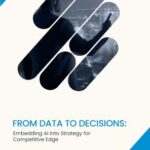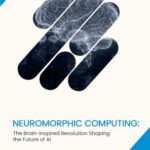or call: +1 (845) 347-8894

or call: +1 (845) 347-8894

Can artificial intelligence go beyond tailoring content to understanding how each learner thinks, feels, and responds to pressure? This is the question forward-thinking educators, technologists, and corporate trainers are now exploring. In 2025, AI in education is no longer about delivering the right module to the right person. It is about decoding learning psychology, fostering micro-motivation, and helping every learner unlock their rhythm of progress. This shift signals a deeper evolution from simple automation to true personalized learning.
While most online articles focus on AI’s ability to automate grading, recommend study materials, or provide 24/7 tutoring, these are just the surface-level applications. The real transformation lies in how AI enables cognitive alignment, an adaptive process where educational systems mold themselves around the mental, emotional, and situational profile of each learner.
Let’s dive into what this means for the future of learning.
Not all learners are visual, logical, or verbal. Some learn best when they move. Others retain better when they teach back. Traditional systems overlook this. Even digital learning tools often simplify learners into standard models.
AI is changing that by detecting and mapping cognitive diversity in ways previously impossible. Through real-time interaction, sentiment detection, eye-tracking, and behavioral patterning, AI can now identify how a learner’s mind engages with content, whether through curiosity, anxiety, boredom, or confidence.
For example, an AI-powered system in a corporate upskilling course might detect that a cybersecurity analyst responds best to scenario-based storytelling, while another prefers decision-tree logic. Rather than choosing between learning formats, AI builds hybrid modules, custom-sequenced to match these preferences.
By understanding this cognitive makeup, AI does not just personalize what is taught, but how it is taught and, more importantly, why a certain format ignites stronger learning.
Learner drop-off is a major problem in online education. But it’s not always about content difficulty. Often, the issue lies in motivation misalignment, a subtle mismatch between the learner’s inner drivers and the system’s engagement style.
Enter AI’s emerging role in micro-motivation mapping. Through predictive analysis, AI systems now assess when a learner is likely to lose focus or disengage, and proactively adapt the challenge level, tone, or even inject humor to retain attention.
Some platforms go further. They trigger micro-achievements, tiny, well-timed wins that activate dopamine spikes and build positive reinforcement. Unlike gamification, which often relies on badges and scores, micro-motivation is psychological. It might use dynamic pacing, progressive hinting, or AI-generated encouragement that aligns with the learner’s past behavior and feedback loops.
This transforms AI from a reactive tool into a motivational coach, helping the learner sustain internal momentum.
A student struggling to grasp cloud infrastructure might not need a simpler explanation; they might need reassurance. Another might be bored by repetition but afraid to move ahead. These aren’t logic problems. They’re emotional barriers that AI is learning to identify and resolve.
Advanced AI models now integrate emotion-adaptive learning, where biometric cues (tone of voice, typing speed, pupil dilation, and even facial expression when permitted) feed into dynamic content adjustment. If frustration is detected, the system softens its pace. If overconfidence emerges, it increases the challenge or introduces a peer-learning opportunity.
Instructors and mentors then receive a behavioral dashboard, not just analytics. This gives them real-time insight into how learners feel about their journey, not just what they’ve completed. It’s not surveillance. It’s support. And it’s proving powerful in environments like high-stakes certification programs or leadership development tracks.
Many AI-driven platforms still follow a static path: finish module A to unlock module B. But that doesn’t reflect how real careers evolve.
AI is beginning to reverse-engineer learning from goals, not curricula. For instance, the system doesn’t just suggest a course if a software developer wants to pivot into AI product management. It evaluates current skillsets, maps industry trends, predicts required proficiencies, and designs a modular, evolving learning journey based on real-world roles.
This is not standard upskilling. It’s career-driven knowledge modeling, where every lesson is a building block toward a practical goal. Even more compelling, these paths can be adjusted mid-journey as learner preferences, job markets, or skill gaps shift.
What if learners had a personal AI companion, not just a tutor, but a guide who grows with them?
Some emerging platforms are prototyping AI companions trained on a learner’s knowledge graph. These companions remember past queries, learning moods, and decision styles. They suggest not just what to learn next, but how to apply it. They provide conversational rehearsal for interviews, simulate real-time problem-solving scenarios, or act as a second brain during project development.
More than just a chatbot, this AI entity evolves alongside the learner, becoming a trusted cognitive partner. In future implementations, this could extend to AR environments, where learners interact with their AI companion spatially, using voice, gestures, or even brain-machine interfaces.
Traditional tests measure recall. But AI-enabled assessments are exploring a different path, capturing thinking processes rather than just correct answers.
Using real-time decision analysis, AI tracks how learners approach complex tasks: do they guess, reflect, revise, or get stuck in loops? These patterns help educators understand cognitive biases, learning gaps, and critical thinking abilities.
This opens the door to narrative-based assessments, where students design systems, critique scenarios, or simulate solutions. The AI evaluates coherence, creativity, logic, and ethical reasoning, not just accuracy. In a world where AI can write an essay in seconds, the ability to evaluate thought construction becomes far more valuable than grading grammar.
Even with all its capabilities, AI isn’t replacing human educators. It’s enhancing them.
Trainers and teachers using AI as a co-creator are seeing better outcomes. They can focus on coaching, dialogue, and mentorship—areas where human empathy and intuition outperform machines. Meanwhile, AI handles the logistics, personalization, and emotional feedback loops.
This hybrid model is showing success in tech bootcamps, executive education, and even K-12 personalized tutoring ecosystems. The goal is not just scalability. It’s depth of impact—reaching each learner where they are, not where the system assumes they should be.
AI is pushing us to rethink the very purpose of education. Personalized learning isn’t about customizing colors, interfaces, or content playlists. It’s about aligning learning with who the learner is becoming, not just what they need to know.
As AI grows in emotional intelligence, cognitive awareness, and career foresight, it becomes a mirror, mentor, and mapmaker guiding learners not just through knowledge but toward self-actualization.
For tech professionals building these systems or integrating them into enterprise L&D strategies, the opportunity is profound: to design experiences that don’t just inform, but transform.
Traditional LMS platforms typically deliver static content and track basic learner progress. In contrast, AI-driven systems analyze learner behavior, cognitive preferences, and emotional responses to personalize learning experiences dynamically. AI can adjust pacing, difficulty, and delivery format in real time based on individual engagement levels and goals.
Cognitive diversity refers to the varied ways people absorb, process, and retain information. AI helps identify these differences through behavioral signals such as reading patterns, response times, or content interaction. By understanding a learner’s cognitive profile, AI can adapt the delivery style to align with how they think best.
Beyond badges and scores, AI now enables micro-motivation, which involves recognizing subtle behavioral shifts and adjusting content to maintain momentum. This might include real-time encouragement, adaptive pacing, or timely success triggers based on past learning behavior and emotional cues.
Yes, advanced AI systems equipped with emotion-detection features can assess factors like tone, typing speed, sentiment in responses, and facial cues (if permitted). This enables systems to sense frustration, boredom, or confidence and respond by adjusting the content or tone to enhance the learning experience.
AI enables reverse learning design, where content paths are built based on a learner’s career goals rather than a static syllabus. It can assess current skills, analyze industry demand, and chart a personalized path toward specific roles, certifications, or skill domains.
To participate in our interviews, please write to our IntentTech Media Room at sudipto@intentamplify.com




